This was published 7 months ago
Take a trip through time in this stunning photo exhibition
There’s deep complexity to the deceptively simple photos of Japanese artist Hiroshi Sugimoto.
In a career of 50 years, Hiroshi Sugimoto, born 1948, has worked to quietly and purposefully refute the idea that photography is a second-class citizen in the world of art. Although known as a photographic artist, Sugimoto is a polymath with interests in science, history, philosophy, theatre, architecture and landscape design. He has been a dealer in high-end antiquities and a notable collector. Viewed as a conceptual artist, he sees himself primarily as a craftsman. “Concept follows craftsmanship” is one of his mottos.
Sugimoto’s masterpiece is not a photograph at all but the Enoura Observatory, which opened in 2017. Set in the Hakone mountains, overlooking Sagami Bay, it is a mix of new buildings and fragments of ancient ones surrounded by citrus trees. Visitors are invited to stroll around the grounds, taking in the views and the forest. Enoura is a total work of art, a place for observing the solstice, for connecting with nature and the legacy of Japan’s medieval period. It’s also an exercise in applied metaphysics, a meditation on life and death.
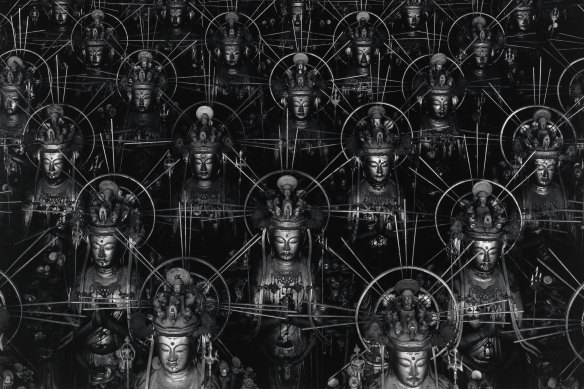
Sea of Buddha 008, 1995.Credit: Hiroshi Sugimoto
The show at the Museum of Contemporary Art, which claims to be the most comprehensive overview of Sugimoto’s oeuvre yet attempted, is aptly titled Time Machine. If there is one subject that features in each of the artist’s diverse series, it is time. He is prepared to take us back to the dawn of consciousness and forward to thoughts of our own mortality.
Sugimoto has investigated ways of slowing down the photographic process, with images produced over a long duration. In other works, he has freeze-framed bursts of lightning or electricity, capturing a permanent record of a mere instant. In an epic series of seascapes, he conjures a sense of timelessness that can’t be found in anything made by humankind.
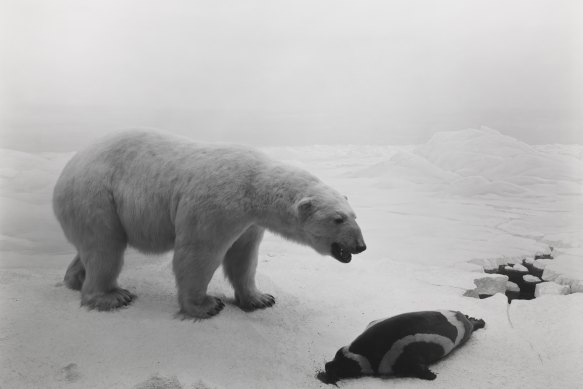
Polar Bear, 1976.Credit: Hiroshi Sugimoto
Believing that photography turns every object into a model, Sugimoto blurs the line between reality and artifice. He aims to imbue inanimate forms with the spark of life or extract the essential idea from iconic works of architecture by setting the focal length of a camera to “twice infinity”. In his Architecture series we have no trouble recognising structures such as the Eiffel Tower, the Solomon R. Guggenheim Museum or the Seagram Building, but they appear as ghostly presences, cropped and fuzzy at the edges. They are monumental but insubstantial, as if we are not looking at the actual structure but an imperfect recollection within our minds.
The first room of the show contains the Dioramas, begun in 1976 when Sugimoto was living in New York. Visiting the Museum of Natural History, he noticed that by closing one eye and squinting, the stuffed animals exhibited in front of painted backdrops took on a new sense of reality. By photographing these creatures and installing them in detail-perfect landscapes, he found he could breathe life into them. When we look at his photos of a polar bear hunting a seal, vultures squabbling over a meal, or a stand-off between a group of ostriches defending their nest against a family of warthogs, we view each scenario as if it were a still from a wildlife documentary.
It’s only gradually that the weirdness of these images strikes home, as the precision of detail is beyond belief. What seems real is revealed as hyperreal, or simply artificial, but this doesn’t diminish the power these pictures exert on our imagination.

Hiroshi Sugimoto’s Henry VIII, 1999; Anne Boleyn, 1999; on display at Hiroshi Sugimoto: Time Machine at the MCA.Credit: Zan Wimberley
A series called Portraits is made up of figures from wax museums such as Madame Tussaud’s of London. This enables the artist to repeat the trick of bringing inanimate figures to life in the most startling manner. Some subjects, such as Princess Diana or Fidel Castro, look as if they might start speaking at any moment.
The series is also notable in that it allows Sugimoto to include characters from different historical periods, from Henry VIII to Napoleon to Oscar Wilde. Time has no power over this gallery which unites an impossible array of celebrities.
There’s also a dark side, tucked away in a virtual closet, with photos of murderers taken from Madame Tussaud’s “Chamber of Horrors”. This is as close to Hollywood as Sugimoto goes.
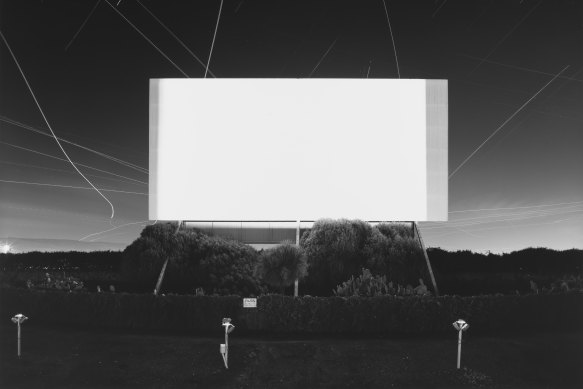
Union City Drive-in, Union City, 1993.Credit: Hiroshi Sugimoto
The movies feature prominently in another series, but only as a hidden presence in pristine images of abandoned cinema palaces or empty drive-ins. Sugimoto tracked down these once-thriving attractions in places such as Kenosha, Wisconsin, or Gary, Indiana, and projected a particular movie on their forgotten screens. By setting the camera to a long exposure time he allowed the entire film to be encompassed within the final image, where it appears as a glowing rectangle of light. Comedies, he found, were brighter than horror movies.
No description can do justice to these uncanny images, at once beautiful and elegiac, each theatre a memento mori for a lost era of popular culture. The golden age of the cinema was probably the 1920s, when movie houses had organs or orchestras and printed programs. Today, as audiences have retreated to their TVs and computer screens, the cinema houses barely limp along.
In Sugimoto’s other series – the Seascapes; the Lightning Fields; the Mathematical Models, which have also found expression as three-dimensional sculptures; the wall-sized Sea of Buddha taken from Sanjusangendo, a famous temple in Kyoto; and finally, the Opticks – he has set and solved a succession of very specific problems. Almost invariably, these solutions have taken a long time to be realised.
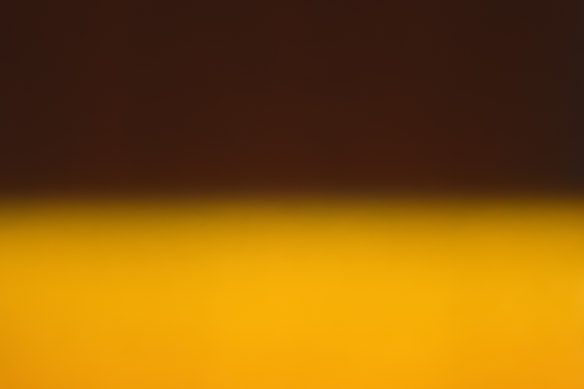
Opticks 195, 2018.Credit: Hiroshi Sugimoto
In the Opticks, for instance, Sugimoto decided to utilise a gift of the final batch of Polaroid film made in Japan to restage Isaac Newton’s famous experiments with prisms that established the colour spectrum. It required six months of early morning sessions searching for the right lighting conditions, the result being a suite of abstract squares of colour. One might imagine anyone could go and photograph a red, blue or yellow surface and get the same result, but to stand in front of these works for a few minutes is to appreciate their depth and subtlety. It’s as if we can sense the time it has taken to achieve these effects, which have distinct affinities with painting.
Like most people, I suspect, the Seascapes were my introduction to Sugimoto’s work. Beginning in 1980 with a photo of the Caribbean, he has taken images of the sea in more than 200 locations, including Bass Strait. The format of every photo is basically the same: a rectangle divided into equal proportions of sea and sky. The surface of the water is dead flat, the skies may be clear or cloudy, the conditions dark or misty, but the effect is mesmerising. In their creation, once again Sugimoto found that achieving an impression of utter simplicity can be a complicated matter.
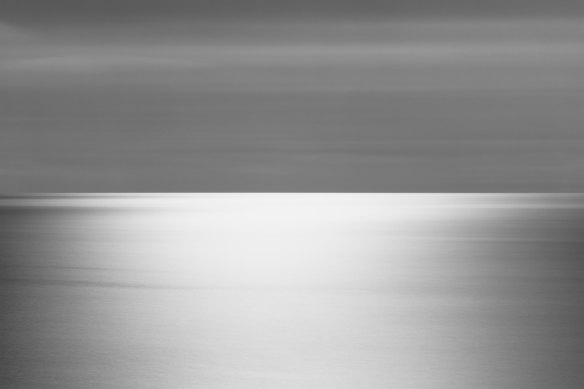
North Atlantic Ocean, Cape Breton Island, 1996.Credit: Hiroshi Sugimoto
There is a deep motivation behind these deceptively simple photos. Sugimoto says they began with a meditation on what people saw in ancient times that we might still see today. In looking at the ocean, we see what the earliest hominids saw when consciousness was in its infancy. It could be argued that even today we respond to this vision in the same primal manner, feeling ourselves absorbed into the ocean’s infinite vistas.
So many artists love to tell us how they engage with themes and ideas, but their methods are often banal in the extreme, hardly more than illustrations of fixed propositions. This is not the case with Sugimoto. In each series, he takes a common motif – the sea, buildings, even colour – and creates works that trigger a range of responses, both visceral and intellectual. These images tantalise us with the thought that the longer we keep looking, the closer we come to solving the impenetrable mysteries of everyday life.
Hiroshi Sugimoto: Time Machine is at the Museum of Contemporary Art until October 27.
To read more from Spectrum, visit our page here.